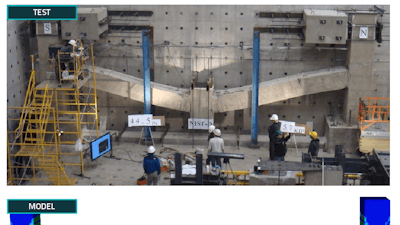
Buildings in the U.S. are generally designed to withstand the usual suspects: rain, wind, snow and the occasional earthquake. Abnormal events such as gas explosions, vehicle impacts or uncontrolled building fires are not typically a consideration. If vulnerable buildings face any of these unanticipated events, the results could be tragic. But now, a new building standard can help engineers prevent the worst.
The American Society of Civil Engineers (ASCE) has released the ASCE/SEI 76-23 Standard for Mitigation of Disproportionate Collapse Potential in Buildings and Other Structures, the first national building standard of its kind. Developed over the course of a decade and informed by research led by the National Institute of Standards and Technology (NIST), the standard provides design requirements and guidance to keep small, isolated failures in a structure from propagating and bringing down the entire building or a major part of it — a phenomenon the standard defines as disproportionate collapse.
“Many different loads are considered in designing a building, but if there’s an unanticipated load that you didn’t explicitly design for, it shouldn’t cause the whole building to collapse,” said NIST research engineer Joseph Main, a member of the ASCE committee that developed the standard.
Disproportionate collapse has always been a risk for large buildings, but the events are rare. For years, the need for a standard in the U.S. aimed specifically at disproportionate collapse was a contentious topic among experts.
After several notable building failures in the ‘90s and early 2000s, a consensus began to form.
In 1995, the Alfred P. Murrah Federal Building collapsed as a result of the Oklahoma City bombing, which initially destroyed three columns — damage that led to the subsequent crumbling of nearly half of the building. During the World Trade Center (WTC) disaster in 2001, the heat of unmitigated fires in the building called WTC7 caused deformations that severed a connection between a girder and column, triggering a progression of failures that brought the building down. At the conclusion of its WTC investigation, NIST highlighted the need for a standard geared at mitigating these collapses along with guidelines and tools for building design.
Based on a proposal NIST made to ASCE, the engineering society formed a new standards committee of dozens of building experts from industry, academia and the federal government.
Instead of prescribing specifications of each component of a building’s structure as many standards do, the committee decided to set performance goals for structures, giving engineers autonomy in coming up with their own design solutions.
“The standard points towards solutions but doesn’t prescribe them,” said Donald O. Dusenberry, consulting engineer and chair of the ASCE committee. “It offers proven methods to analyze and design structures for disproportionate collapse but allows for cost-effectiveness and creativity.”
The required performance and level of hazard (for example, the extent of initial damage that the structure should withstand) varies depending on the size, occupancy and utility of a building.
“Those designing government buildings or any buildings that are critical for communities, I think, would be the first groups looking carefully at this standard,” said NIST research structural engineer Fahim Sadek, a member of the same ASCE disproportionate collapse committee.
To inform the standard’s requirements, NIST researchers spearheaded an effort to elucidate the mechanics of what happens when sections of a structure are removed — an area of previously uncharted territory.
“The loading scenario for the connections is quite different from what you would typically get under wind, earthquake or gravity loads that people are used to designing for,” Main said. “It’s a much more complex condition.”
Over nearly a decade, the researchers carried out numerous computer simulations of building components giving out. In one of many simulations, they removed the middle of three columns from a structural frame and applied forces above the missing column until connections fractured.
Due to the complexity and lack of existing data for these types of events, the researchers replicated many of these scenarios in the real world. The team built and destroyed either fractions of or entire building structures to produce data to ensure that their simulations were realistic.
The experiments were useful for identifying the degree that beams and connections can rotate and bend before a structure is overwhelmed and crumbles.
But the data’s utility went beyond informing the standard’s requirements. The researchers also used the findings to develop simplified modeling approaches for evaluating the susceptibility of buildings to disproportionate collapse.
Engineers commonly use computer models to confirm that their designs will hold up to loads and forces traditionally considered. A separate ASCE technical committee, which Main recently led, is working to release guidelines that help designers harness computer modeling tools for disproportionate collapse mitigation.
Different modeling approaches are already available, from powerful models suitable for detailed analysis of individual building components to simplified models meant for the evaluation of entire buildings. Engineers could use these types of resources to test the integrity of their designs under various hazard scenarios described in the standard.
For now, the standard is a valuable resource that can be used voluntarily; however, down the line, the entire standard, or part of it, may be incorporated into the model building code and adopted by state and local jurisdictions.






















